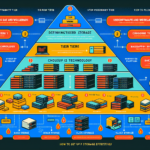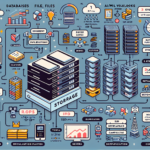Handling long-term data archival requires a well-thought-out strategy to ensure data integrity, security, accessibility, and compliance over time. Here are the steps and best practices for long-term data archival:
1. Assess Your Archival Needs
- Data Type: Determine the types of data you need to archive (e.g., compliance data, logs, historical records, media files).
- Retention Period: Define how long the data needs to be kept based on legal, regulatory, or business requirements.
- Access Frequency: Understand how often you may need to retrieve the archived data.
2. Choose the Right Storage Medium
Long-term archival requires reliable storage solutions. Consider the following options:
Tape Storage (LTO – Linear Tape-Open)
- Advantages: Extremely cost-effective for large-scale storage, long shelf life (10–30 years), and low power consumption.
- Disadvantages: Slower access speeds compared to disk/cloud.
Cloud Storage
- Advantages: Scalability, pay-as-you-go pricing, built-in redundancy, and accessibility from anywhere.
- Disadvantages: Long-term costs can accumulate, dependency on a third-party provider, and potential latency.
Object Storage
- Ideal for unstructured data with metadata support.
- Examples: On-premises solutions like Dell ECS or cloud-based options like AWS S3 Glacier or Azure Archive Storage.
Cold Storage
- Designed for rarely accessed data with lower costs.
- Examples: Google Coldline, AWS Glacier.
Optical Media (Blu-ray/DVD)
- Advantages: Long lifespan and immunity to electromagnetic interference.
- Disadvantages: Limited capacity and slower access speeds.
Hard Drives & SSDs
- Suitable for short- to medium-term archival; not ideal for decades due to potential mechanical failures.
3. Implement Data Redundancy
- Use RAID configurations for on-premises storage.
- If using cloud solutions, ensure the provider offers redundancy and replication across regions.
- Maintain multiple copies of critical data across different mediums (e.g., tape and cloud).
4. Ensure Data Integrity
- Regularly verify archived data using checksums or hash algorithms.
- Implement data scrubbing to detect and correct corruption.
- Use write-once-read-many (WORM) technologies to prevent accidental overwrites.
5. Automate Archival Processes
- Use backup and archival software like Veeam, Commvault, or Veritas to automate data movement to archival storage.
- Set policies for automatic tiering (e.g., moving old or infrequently accessed data to archival storage).
6. Address Compliance Requirements
- Understand regulations like GDPR, HIPAA, SOX, or PCI DSS and ensure your archival solution meets these standards.
- Implement audit trails to track access and modifications of archived data.
7. Secure Archived Data
- Encrypt data at rest and in transit to protect sensitive information.
- Restrict access using role-based access control (RBAC).
- Store encryption keys securely (e.g., in hardware security modules or key management systems).
8. Plan for Scalability
As data volumes grow, ensure your archival solution can scale without requiring disruptive migrations. Object storage and cloud solutions are particularly suitable for this.
9. Test Retrieval Processes
- Periodically test the ability to retrieve archived data.
- Document retrieval procedures for future reference.
10. Monitor Archival Costs
- Regularly evaluate the cost-effectiveness of your solution.
- Move data to lower-cost tiers (e.g., from warm storage to cold storage) as access requirements decrease.
11. Disaster Recovery
- Integrate archival data into your disaster recovery plan.
- Ensure archived data is stored in geographically diverse locations.
12. Plan for Technology Obsolescence
- Periodically assess the risk of storage technology becoming obsolete.
- Migrate data to newer formats or mediums as needed (e.g., upgrading from LTO-6 to LTO-9 tapes).
Recommended Tools and Solutions
- Tape Libraries: Dell PowerVault, HPE StoreEver.
- Cloud Providers: AWS Glacier, Azure Archive Storage, Google Cloud Coldline.
- Backup & Archival Software: Veeam, Commvault, Veritas NetBackup, Rubrik.
- Object Storage: MinIO, Dell ECS, AWS S3.
Example Workflow
- Implement a tiered storage system:
- Active data: SSD/HDD or high-performance storage.
- Cold data: Tape or cloud archival.
- Automate data movement using policies.
- Encrypt, compress, and verify data during archival.
- Store multiple copies in geographically diverse locations.
- Regularly test retrieval and monitor storage health.
By following these guidelines, you can implement a robust and cost-effective long-term data archival solution tailored to your organization’s needs.



